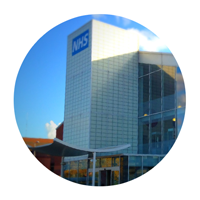Our Trust doesn’t collect much of this data. We have answered below where we have information. We have attached the C.diff mortality data and surveillance policy.13_10 Enc 5b Copy of Cdiff Q4 2011-12 30day mortality Data- HEFT Copy of Cdiff Quarterly 30day mortality Data- HEFT (2) Surveillance Policy
The remainder of the data you are looking for is available through Health Protection Agency (Public Health England) site which is open public access and lists results by hospital.
· Your Trust’s total surgical site infection rate (all cause) no data
· The total number of cases where each of the following were mentioned as either a cause or a contributory factor in a death certificate at your Trust:- no data other than C.diff file attached
i. MRSA (health care acquired)
ii. Escherichia coli (health care acquired)
iii. MSSA (health care acquired)
iv. CDIF (health care acquired)
v. Septicemia (health care acquired)
vi. Sepsis (health care acquired)
vii. Catheter-associated urinary tract infections (health care acquired)
viii. Catheter-related bloodstream infections (health care acquired)
ix. Central line-associated bloodstream infections (health care acquired)
x. Ventilator-associated pneumonia (health care acquired)
xi. Norovirus (health care acquired)
· The total number of cases where each of the following were mentioned as either a cause or a contributory factor in a death certificate at your Trust:- no data other than C.diff file attached
i. MRSA (community acquired)
ii. Escherichia coli (community acquired)
iii. MSSA (community acquired)
iv. CDIF (community acquired)
v. Septicemia (community acquired)
vi. Sepsis (community acquired)
vii. Catheter-associated urinary tract infections (community acquired)
viii. Catheter-related bloodstream infections (community acquired)
ix. Central line-associated bloodstream infections (community acquired)
x. Ventilator-associated pneumonia (community acquired)
xi. Norovirus (community acquired)
·
- MRSA acquired within the T
- ii. Escherichia coli acquired within the Trust
- MSSA acquired within the Trust –
- iv. CDIF acquired within the Trust – v. Septicemia acquired within the Trust vi. Sepsis acquired within the Trust n
vii. Catheter-associated urinary tract infections acquired within the Trust
viii. Catheter-related bloodstream infections acquired within the Trust
ix. Central line-associated bloodstream infections acquired within the Trust
x. Ventilator-associated pneumonia acquired within the Trust
xi. Norovirus acquired within the Trust
· The total number of cases of no data other than above
i. MRSA treated within the Trust as per national return available on HPA web site
ii. Escherichia coli treated within the Trust as per national return available on HPA web site
iii. MSSA treated within the Trust as per national return available on HPA web site
iv. CDIF treated within the Trust as per national return available on HPA web site
v. Septicemia treated within the Trust no data
vi. Sepsis treated within the Trust no data
vii. Catheter-associated urinary tract infections treated within the Trust no data other than safety thermometer audit see national return
viii. Catheter-related bloodstream infections treated within the Trust no data
ix. Central line-associated bloodstream infections treated within the Trust no data
x. Ventilator-associated pneumonia treated within the Trust no data
xi. Norovirus treated within the Trust no data on individual patients as we don’t test all patients during an outbreak. Dileepa can give details of wards closures if FOI is followed up with this request
· The total number of patients who stayed in hospital longer (extended stay) owing to: no data
i. MRSA acquired within the Trust
ii. Escherichia coli acquired within the Trust
iii. MSSA acquired within the Trust
iv. CDIF acquired within the Trust
v. Septicemia acquired within the Trust
vi. Sepsis acquired within the Trust
vii. Catheter-associated urinary tract infections acquired within the Trust
viii. Catheter-related bloodstream infections acquired within the Trust
ix. Central line-associated bloodstream infections acquired within the Trust
x. Ventilator-associated pneumonia acquired within the Trust
xi. Norovirus acquired within the Trust
· The aggregate number of nights patients stayed in hospital longer, beyond the trim point, owing to: no data
i. MRSA acquired within the Trust
ii. Escherichia coli acquired within the Trust
iii. MSSA acquired within the Trust
iv. CDIF acquired within the Trust
v. Septicemia acquired within the Trust
vi. Sepsis acquired within the Trust
vii. Catheter-associated urinary tract infections acquired within the Trust
viii. Catheter-related bloodstream infections acquired within the Trust
ix. Central line-associated bloodstream infections acquired within the Trust
x. Ventilator-associated pneumonia acquired within the Trust
xi. Norovirus acquired within the Trust
· The aggregate number of nights patients stayed in hospital longer, not just days beyond the trim point, owing to: no data
i. MRSA acquired within the Trust
ii. Escherichia coli acquired within the Trust
iii. MSSA acquired within the Trust
iv. CDIF acquired within the Trust
v. Septicemia acquired within the Trust
vi. Sepsis acquired within the Trust
vii. Catheter-associated urinary tract infections acquired within the Trust
viii. Catheter-related bloodstream infections acquired within the Trust
ix. Central line-associated bloodstream infections acquired within the Trust
x. Ventilator-associated pneumonia acquired within the Trust
xi. Norovirus acquired within the Trust
· The total revenue from excess bed days caused by patients with an SSI (a) by procedural type and (b) by speciality? No data
Please also explain:
· Did your Trust receive instructions in (a) 2008/09, (b) 2009/10, (c) 2010/11, (d) 2011/12 or (e) 2012/13 to reduce expenditure on infection, prevention and control? Instructions from whom?
· What strategy does your Trust have in place for the surveillance and minimisation of harm caused by infections not covered in the mandatory surveillance programme? – see attached surveillance policy
· Does the Trust carry out any surgical site infection surveillance that it does not report to Public Health England? Occasionally if included in annual programme
§ If yes, please specify the protocol, the types of surgeries included and results. This year thoracic surgery
· Does the Trust carry out any post discharge surgical site surveillance on any category? This year thoracic surgery
§ If yes, what are the numbers of readmission linked to surgical site infection at your Trust? No data until later in year
· Does the Trust carry out any financial analysis on the cost or operational impact of infections locally? no
§ If yes, please share this.
§ If not, please could you give reasons why
· Does the Trust carry out any post discharge surgical site surveillance on any category?
§ If yes, what are the numbers of readmission linked to surgical site infection at your Trust?
· What surveillance systems and processes did you have for active infection control in 2012/13? As per policy
· How many staff were dedicated to the surveillance of infections and/or the analysis of that data in 2012/13? Surveillance part of nursing team role. One full time data analyst
· How many staff were on your infection prevention and control team in (a) 2008/09, (b) 2009/2010, (c) 2010/11, (d) 2011/12 and (e) 2012/13? 12 nurses in 2008/9 gradual reduction to 9.8 over these years no detailed record kept of reduction timescale.
· What was the ratio of infection control staff (ie infection control doctors, infection control nurses, dedicated infection control surveillance auditors) to beds in Acute care at your Trust in 2012/13? One DIPC (microbiologist) several microbiologists and virologists difficult to allocate specific wte to infection prevention work, one wte data analyst plus support form performance team, 9.8 wte nurses
· On how many wards did you do device surveillance in 2012/13? Nil other than MSSA bacteraemias related to devices
· On how many wards did you not do device surveillance in 2012/13? –see above
· How many times in (a) 2008/09, (b) 2009/2010, (c) 2010/11, (d) 2011/12 and (e) 2012/13 was a member of the Board present at an infection prevention and control committee meeting? This is chaired by chief nurse who is board member
· How many business cases were submitted by Infection Control in (a) 2008/09, (b) 2009/2010, (c) 2010/11, (d) 2011/12 and (e) 2012/13?
§ For each year, how many of the above business cases were successful? 2012/13 case for increased glossair air machines successful
· What was your budget for infection prevention and control in (a) 2008/09, (b) 2009/2010, (c) 2010/11, (d) 2011/12 and (e) 2012/13? Budget for 2012/13 is £504,912. I have not kept records of previous budget allocation from 2010 but is about the same. Prior to this under HPA no allocated budget
· Do you have standardised infection control protocols and technology utilisation across all wards of the Trust? Standard protocols in use unsure what is meant by standardised technology






